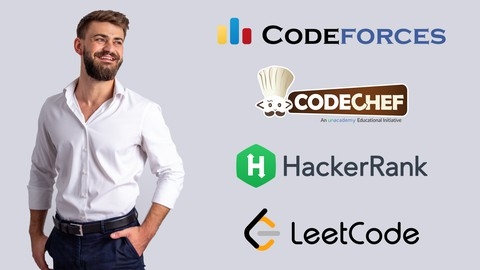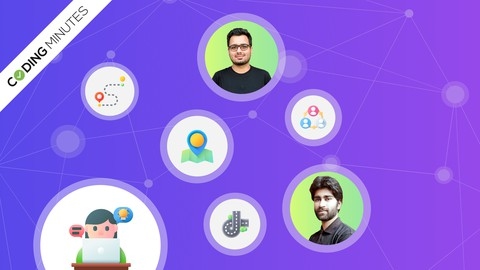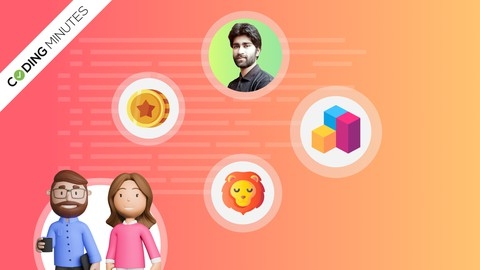Competitive programming is a challenging yet rewarding field that requires a deep understanding of algorithms, data structures, and efficient coding practices.
Mastering these skills not only helps you excel in programming contests but also equips you with valuable problem-solving abilities applicable to diverse software development scenarios.
Learning competitive programming can boost your technical skills, enhance your logical reasoning, and even open up exciting career opportunities in the tech industry.
Finding the right competitive programming course on Udemy can feel like searching for a needle in a haystack, given the vast number of options available.
You’re looking for a program that caters to your level, offers clear explanations, provides practical exercises, and prepares you for real-world challenges.
For the best competitive programming course overall on Udemy, we highly recommend Competitive Programming Essentials, Master Algorithms.
This comprehensive program covers a wide range of essential topics, from the fundamentals of algorithms and data structures to advanced concepts like dynamic programming and graph theory.
It’s perfect for beginners who want to gain a strong foundation and build a robust skillset.
The course includes numerous coding exercises, real-world examples, and helpful tips from experienced instructors, ensuring you master the concepts and gain the confidence to tackle any programming challenge.
While Competitive Programming Essentials, Master Algorithms stands out as our top pick, there are plenty of other great courses on Udemy tailored to different learning styles and goals.
Continue reading to discover our recommendations for beginners, intermediate programmers, and those interested in specific programming languages or areas of focus.
Competitive Programming Essentials, Master Algorithms
This course takes you on a comprehensive journey, starting with the fundamentals and gradually building up to advanced concepts.
You will learn with this course the ins and outs of algorithms, data structures, and how to analyze time and space complexity.
These are essential skills for any aspiring programmer, and the course ensures you get a strong foundation.
You’ll dive into Big O Notation, understanding how to measure and optimize algorithm efficiency.
Transitioning smoothly, the course then takes you through a wide range of data structures, including arrays, stacks, queues, and priority queues.
You’ll get hands-on with C++ and Java, implementing these data structures and mastering their intricacies.
If you’re interested in the nitty-gritty of bit manipulation, there’s a dedicated section just for that, teaching you how to work with bits and perform bitwise operations efficiently.
The course also covers essential problem-solving techniques, like recursion and backtracking, ensuring you can tackle complex problems with confidence.
You’ll explore dynamic programming, a powerful tool for solving optimization problems, and learn how to apply it in various scenarios.
Additionally, the course provides a solid grounding in graph theory and graph algorithms, teaching you about traversals, shortest paths, and tree structures.
You’ll get to grips with classic algorithms like Dijkstra’s and Bellman-Ford’s, and understand how to find the shortest path in a graph efficiently.
With a focus on practical skills, the course includes webinars and tutorials on setting up your coding environment with IDEs and Sublime Text, ensuring you’re ready to code efficiently.
The Bible of Competitive Programming & Coding Interviews
This course covers a wide range of topics and will help you build a solid foundation in algorithms, data structures, and coding techniques.
You’ll start with the basics, learning about algorithms, data structures, and complexity analysis.
This foundation will give you the tools to understand and analyze the efficiency of different approaches.
Then, the course dives into essential programming concepts like loops, arrays, and strings.
You’ll learn how to manipulate and analyze data efficiently, which is crucial for solving complex problems.
Transitioning smoothly, the course introduces you to the world of competitive programming.
You’ll tackle challenges like the Maximum Number of Groups Problem and the Minimum Number of Boats Problem, honing your problem-solving abilities.
The course also covers advanced data structures such as stacks, queues, and deques, as well as essential algorithms like binary search and merge sort.
In the realm of binary trees, you’ll explore symmetric trees, binary tree traversal, and the Kth smallest element in a binary search tree.
The course also delves into dynamic programming, a powerful technique used to solve complex problems by breaking them down into smaller, manageable subproblems.
You’ll learn how to apply dynamic programming to find the longest increasing subsequence and solve the famous 0/1 knapsack problem.
Additionally, the course includes bonus sections on competitive programming and coding interviews.
These sections provide extra practice and guidance to ensure you’re well-prepared for any challenge.
With tasks and problems to work through, you’ll be able to test your understanding and identify areas for improvement.
Throughout this course, you’ll develop a robust toolkit of problem-solving strategies and gain the confidence to tackle any coding challenge that comes your way.
It offers a well-rounded approach to competitive programming and coding interview preparation, making it a valuable choice for anyone aspiring to excel in these fields.
Graph Theory Algorithms for Competitive Programming
Starting with the basics, you will learn about graph representation and key terms.
You will then dive into different types of graph representations, such as adjacency lists and how to find the center of a star graph.
The course also covers important concepts like maximal network rank and connected graphs.
One of the key strengths of this course is its focus on practical application.
You will work with exercises and code repositories in C++ and Java to reinforce what you learn.
For example, you will tackle problems like finding the minimum degree of a connected trio in a graph.
If you’re interested in a particular topic, there are also optional webinars to explore.
As you progress, you will be introduced to essential graph traversal algorithms, including Breadth-First Search (BFS) and Depth-First Search (DFS).
You will learn how to implement these algorithms and apply them to various problems, such as the snakes and ladders game, or finding the largest island in a graph.
The course also covers advanced topics, such as cycle detection in both undirected and directed graphs, and introduces you to topological sorting.
You will learn about minimum spanning trees and how to find the shortest path with algorithms like Dijkstra’s and Bellman-Ford.
If you want to improve your competitive programming skills, this course provides a comprehensive and practical guide to graph theory algorithms.
You will gain a strong foundation in graph theory and be able to apply these concepts to a wide range of programming challenges.
Beginner’s guide to Competitive programming using python
Designed with beginners in mind, this course offers a step-by-step guide to competitive programming using Python.
The course starts with an introduction, laying the foundation for your competitive programming journey.
You will learn about the basics of competitive programming, including the tools and techniques used by expert programmers in competitions.
From there, you’ll dive into writing your first competitive programs.
You will learn how to create efficient and effective code, a crucial skill for any programmer.
The course will introduce you to Big O Notation, a fundamental concept in computer science that will help you analyze and improve the efficiency of your algorithms.
As you progress, you’ll explore popular algorithms and data structures used in competitive programming.
You will learn about the Binary Search Algorithm, a powerful tool for efficiently finding the position of a target value within a sorted array.
The course will also teach you how to find the peak index in a mountain array, a common problem in competitive programming contests.
If you’re interested in algorithm optimization, you will enjoy the section on the Sieve of Eratosthenes.
This ancient algorithm for finding prime numbers will be explained in a modern context, showing you how to optimize your code for speed and efficiency.
Throughout the course, you will also learn about finding the frequencies of elements in arrays or strings, a common task in many programming challenges.
Algorithms for Job Interviews and Competitive Programming
The course starts with the basics, ensuring that everyone is on the same page.
You’ll get a quick introduction to runtime analysis and big-O notation, which are essential concepts for understanding algorithm efficiency.
Additionally, if you’re new to C++, there’s a section dedicated to getting you familiar with the language, specifically tailored for competitive programmers.
Moving on, you’ll dive into one of the most important topics in competitive programming: graphs.
The course first introduces you to the basic terms and representations of graphs, and then you’ll learn about two fundamental graph traversal algorithms: depth-first search and breadth-first search.
You’ll also explore topological sorting, which is crucial for understanding the order in which to process elements in a graph.
As you progress, you’ll encounter Dijkstra’s algorithm, a powerful tool for finding the shortest path in a graph.
The course breaks down this algorithm into easily digestible parts, helping you understand, analyze, and eventually implement it.
And if you come across graphs with negative edges, don’t worry; the Bellman-Ford algorithm is covered, too, along with the Floyd-Warshall algorithm for finding all distances in a graph.
Dynamic programming is another key topic in competitive programming, and this course dedicates a significant portion to it.
You’ll learn how to write faster algorithms using dynamic programming techniques, starting with a basic understanding of recursion and memorization.
The famous knapsack problem is also covered, along with dynamic programming applications on trees.
With this course, you will develop a strong foundation in competitive programming and be able to tackle a wide range of algorithmic challenges with confidence.
Game Theory Algorithms in Competitive Programming
The course covers a wide range of topics and will help you develop a strong understanding of game theory and its applications in competitive programming.
You’ll start with the basics, setting up your coding environment with Sublime Text and learning how to organize your code with master header files.
This foundation will ensure you have a smooth and efficient workflow.
The course then dives into the exciting world of game theory, teaching you about take-away and combinatorial games.
You’ll learn about classic games like Nim and Divisor, and understand the strategies and algorithms that power them.
As you progress, the course introduces the Misère rule, which adds a whole new layer of complexity to these games.
You’ll tackle examples and problems that challenge your understanding and help you apply the concepts.
If you’re feeling lucky, there’s even a lesson on “Lucky Number,” where you’ll explore the maximum number of coins and how to predict the winner.
The course also covers the NimSum and its applications, helping you understand how to use this powerful tool in games like the Game of Bullets.
You’ll learn about similar games, such as the Stair Game, and delve into the Sprague Grundy Function, a key concept in game theory.
The course explains how to code this function and illustrates its applications with examples.
You’ll also explore games as graphs and understand how to represent them in this way.
The famous Matrix Game and Friends Game are covered, along with unique games like Ada Pawns and Grundy’s Game.
The problem sets in this course are extensive and provide a great opportunity to apply what you’ve learned.
From the Game of Stones to Tower Breakers, and even a revisit of certain topics with problems like “Tower Breakers Again,” you’ll have ample practice to reinforce your understanding.
Competitive Programming
Starting with the basics, you’ll learn about online judges and the different types of problems you’ll encounter in programming contests.
You’ll also cover essential programming concepts like input/output (I/O) and sorting.
The course then introduces you to C++ custom comparators and data structures, including stacks, queues, and BST- and heap-based structures.
Transitioning smoothly, you’ll explore searching algorithms, such as linear and binary search, as well as the Two Pointer Technique.
The course also covers a range of sorting algorithms, from Merge Sort and QuickSort to more specialized sorts like Count Sort and Bucket Sort, ensuring you can select the right tool for the job.
As you progress, you’ll delve into Standard Template Library (STL) data structures and learn how to use them effectively.
This includes a focus on STL stacks, queues, and hash tables, providing you with powerful tools for managing data efficiently.
The course also covers unordered and ordered sets and maps, giving you a deep understanding of data organization and retrieval.
Moving forward, you’ll be introduced to the world of hashing, with a detailed explanation of hash functions and how to handle collisions.
The Rabin-Karp case study brings these concepts to life, teaching you how to search for patterns and use rolling hash functions efficiently.
The course also ensures you understand greedy algorithms and can demonstrate their correctness under contest time pressure.
You’ll tackle problems like coin change and interval covering, developing a strategic mindset for solving complex challenges.
It strikes a balance between theory and practice, ensuring you not only understand the concepts but also know how to apply them.
Java for Competitive Programming from Scratch - Intermediate
If you’re looking to improve your competitive programming skills and Java is your language of choice, this course is an excellent choice.
It covers all the bases, from the very beginning to more advanced topics, ensuring you have a solid foundation and a competitive edge.
The course starts with the basics, introducing you to Java and guiding you through the installation and setup of your programming environment.
You’ll learn about variables, data types, operators, and expressions, building a strong foundation for your future coding endeavors.
If you’re new to Java, this course has you covered with an introduction to the language and its fundamentals.
Transitioning smoothly, you will then dive into input and output classes, control flow, and decision-making statements.
These are essential tools for any programmer, and the course ensures you understand how to use them effectively in Java.
The loop and decision-making statements will empower you to create dynamic and intelligent programs that can adapt to different scenarios.
As you progress, the course introduces you to the world of competitive programming.
This is where your skills will truly be put to the test, and you’ll learn some advanced Java concepts along the way, including string manipulation and arrays.
You will also explore functions and methods, access modifiers, and constructors, giving you a comprehensive understanding of Java’s capabilities.
Furthermore, the course covers key programming concepts such as functions, methods, and access modifiers.
You will learn how to create your own functions and methods, control access to your code, and utilize constructors effectively.
These are essential tools for creating modular, reusable, and efficient code, which is crucial in competitive programming.
One of the standout features of this course is its inclusion of inheritance, a major concept in Java.
You will understand how to use the “extends” keyword and inherit the properties and behaviors of existing classes, allowing for efficient code reuse and the creation of hierarchical relationships between classes.








